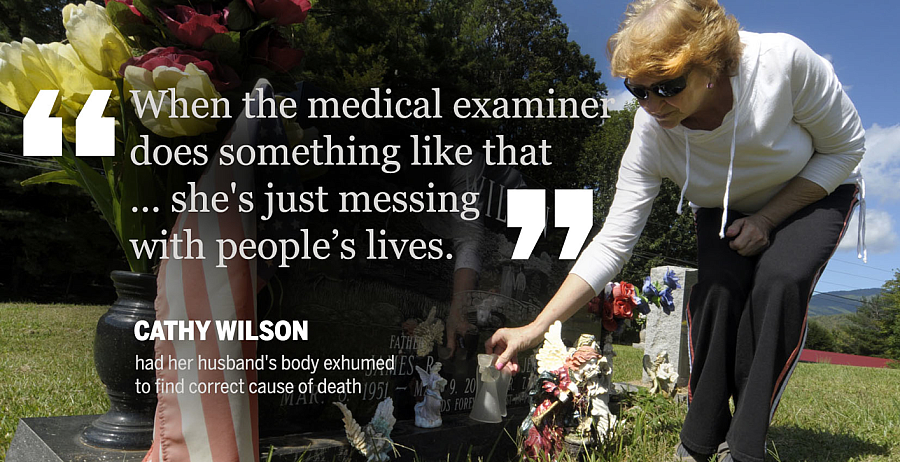Fatally Flawed: Three lessons from the Observer’s medical examiner series

(Image from the Charlotte Observer)
It’s not often that journalists get to use the phrase “Killers can go free.”
And a jaded public would have good reason to doubt that phrase were they to see it bouncing around Twitter or shouting at them in ALL CAPS in an email chain.
But the team bringing us that finding – that killers are going free because North Carolina’s medical examiner system is failing – is from the Charlotte Observer, one of the most decorated local papers in the country with some of the most talented reporters and writers. Here’s what Ames Alexander, Gavin Off, Fred Clasen-Kelly and Elizabeth Leland found in “Fatally Flawed,” their five-part series:
Across North Carolina, medical examiners fail to follow crucial investigative steps, raising questions about the accuracy of thousands of death rulings.
The living face the consequences.
Widows can be cheated out of insurance money. Families may never learn why their loved ones died. Killers can go free.
Here are three lessons from series:
Do point fingers. The reporters knew that the public would not care about medical examiners cutting corners if there were no real consequences. And so they found cases where foot-dragging on identifying a gas leak in a hotel as a cause of death, for example, allowed the same gas leak to kill an 11-year-old boy. They also found that sometimes medical examiners don’t fully examine the dead person’s body. And they tracked these examiners down to ask them why. In the case of the late David Worley, his death was ruled a car accident, until one of his children told someone in the family that Worley had been stabbed by his wife.
The local medical examiner – a 65-year-old family doctor named Dr. Linda Robinson – said she viewed Worley’s body at the morgue but didn’t see the stab wounds because she didn’t turn over the 218-pound corpse.
“Even if I wanted to turn it over, I couldn’t have,” she said, explaining that she has had knee and ankle surgeries in recent years and walks with a cane.
In failing to view the back of the body, Robinson violated a state guideline: “The body should be critically inspected, including the back, both before and after removal of clothing.”
… Had the child not spoken up, the suspect “could have gotten away with murder,” Robinson acknowledged. “There’s no doubt about it.”
Make your measures relevant. The Observer team created a database based on medical examiner records going back to 2001. And they created a series of graphics that allow readers to compare counties and view trends over time. There are many different dimensions they could have highlighted, but they started with the things that they knew would connect with most people. The question they asked of the data is so basic that it might slip past many reporters: Did the medical examiner actually look at – or view, in examiner parlance – the body? The Observer wrote:
In Rowan County north of Charlotte, medical examiners failed to look at bodies in four of every 10 deaths they investigated. The worst performance came in Chatham County, a historically rural area in the geographic heart of the state, now a popular bedroom community to the Research Triangle. Medical examiners there did not view bodies in six of every 10 deaths.
There are actually two lessons here. When you go to investigate whether people are doing a good job or a bad job, you have to first ask whether they are doing their job at all. Second, when you can distill the inadequacies of performance down to something as simple as “did not view bodies in six of every 10 deaths,” you are guaranteed to connect with readers who are busy, information overloaded, or just plain disinterested. That ratio has an outrage factor that so many other ways of looking at the data don’t.
Travel. In an era where even the most promising plans to alter the course of newspapers are turning out to be dead ends, it can be hard for reporters to successfully argue that they need to leave the state – let alone the city – to report a story. Fred Clasen-Kelly made the case, and the Observer is to be commended for providing the resources for his reporting in Maryland, which yielded some of the most important information provided in the series. Clasen-Kelly compared how Maryland’s medical examiner system operates and how North Carolina’s operates – or attempts to operate. He wrote:
North Carolina officials acknowledge the need for changes.
State Chief Medical Examiner Deborah Radisch said her office can’t operate like a system that spends more money. Maryland spends $1.97 per capita on its death investigations. The national average is $1.76 per capita, according to a 2007 survey by the National Association of Medical Examiners.
North Carolina spends less than half that – about 84 cents per capita.
In his May 13 budget proposal, Gov. Pat McCrory asked lawmakers for an additional $1 million to improve suspicious death investigations. The state and counties spent $8.3 million on the medical examiner system in fiscal year 2013.
Clasen-Kelly provided all the important caveats and explained how North Carolina has more jurisdictions to cover, etc. But he also showed with clear detail how the entire approach in Maryland is much more focused on arriving at answers about suspicious deaths, not just checking off boxes on a form.
Image from the Charlotte Observer.

